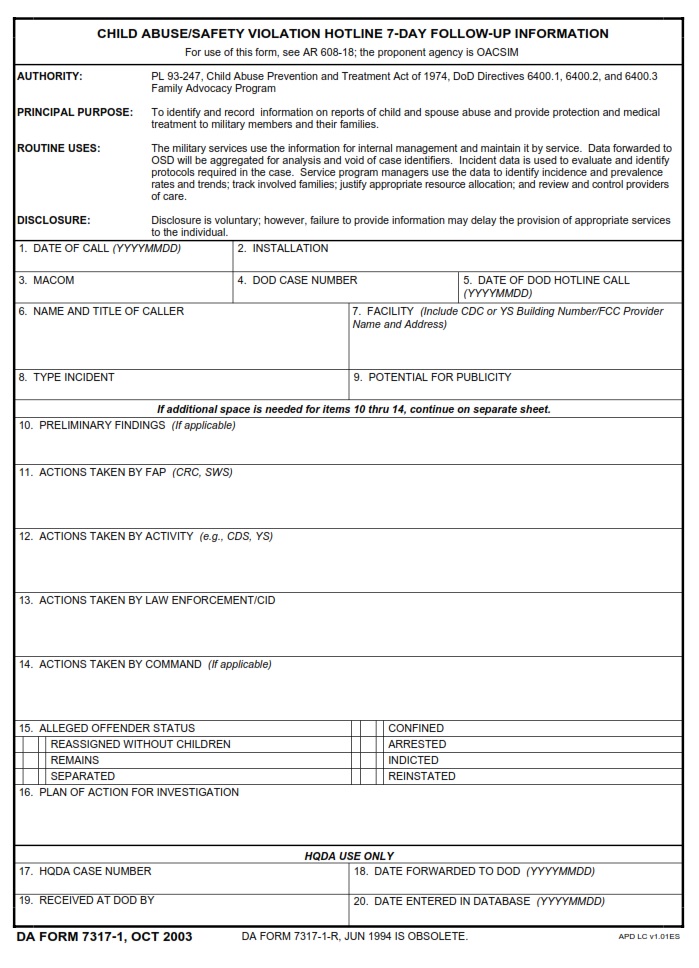Table of Contents
FREE-ONLINE-FORMS.COM – DA Form 7317-1 – Child Abuse/Safety Violation Hotline 7-Day Follow-Up Information – In a world where child abuse remains a pervasive issue, the DA Form 7317-1 emerges as not just a piece of paperwork, but a lifeline for safeguarding innocent lives. This hotline serves as a beacon of hope in the darkness, offering swift intervention and protection for those most vulnerable. As we delve into the critical 7-day follow-up information provided by this form, we uncover a system designed to ensure that no cry for help goes unheard and no child is left in harm’s way. Join us on a journey through the intricacies of this vital tool, exploring how it stands as both a testament to our commitment to child safety and an urgent call to action in the battle against abuse.
Download DA Form 7317-1 – Child Abuse/Safety Violation Hotline 7-Day Follow-Up Information
| Form Number | DA Form 7317-1 |
| Form Title | Child Abuse/Safety Violation Hotline 7-Day Follow-Up Information |
| Edition Date | 10/1/2003 |
| File Size | 49 KB |
What is a DA Form 7317-1?
The DA Form 7317-1 is a critical document used by military authorities to ensure the safety and well-being of children on military installations. This form is specifically designed for reporting suspected child abuse or safety violations through the Child Abuse Safety Violation Hotline. Once a report is filed, it initiates a 7-day follow-up process to thoroughly investigate and address any concerns raised.
During this follow-up period, trained professionals meticulously review each case, interview witnesses, and assess the overall environment to ensure that proper measures are taken to protect the welfare of the child in question. Timely responses and close monitoring are essential components of this process to prevent further harm and provide necessary support for those affected by such incidents. The DA Form 7317-1 plays a crucial role in upholding accountability and prioritizing the safety of vulnerable individuals within military communities.
Where Can I Find a DA Form 7317-1?
If you are in need of a DA Form 7317-1 to follow up on Child Abuse Safety Violations reported to the Hotline, it is important to know where you can obtain this crucial document. One primary source for accessing the form is through official military channels such as your unit’s administrative office or through online resources provided by the Department of Defense. Additionally, you may also reach out to designated personnel at your installation who have access to these forms and can assist you in obtaining a copy promptly.
It is essential for individuals responsible for following up on child abuse safety violations within the military community to be proactive in seeking out necessary documentation like the DA Form 7317-1. By being aware of where to find this form and taking prompt action in acquiring it, they can ensure that investigations and follow-up actions proceed efficiently according to established protocol. Understanding the importance of timely reporting and proper documentation is key in safeguarding the well-being of all individuals, especially vulnerable children within military settings.
DA Form 7317-1 – Child Abuse/Safety Violation Hotline 7-Day Follow-Up Information
The DA Form 7317-1, also known as the Child Abuse Safety Violation Hotline 7-Day Follow-Up Information, plays a crucial role in ensuring the safety and well-being of children at risk. This form serves as a vital tool for reporting and tracking cases of child abuse or neglect, providing necessary follow-up information within a strict seven-day window. By documenting and closely monitoring these cases, authorities can swiftly intervene and take necessary actions to protect vulnerable children from harm.
This stringent follow-up system outlined in the DA Form 7317-1 reflects a commitment to proactive measures against child abuse, emphasizing the urgent need for timely intervention in such critical situations. The structured timeline for follow-up serves as a reminder of the immediacy required when dealing with potential instances of child endangerment. Through effective utilization of this form and adherence to its guidelines, stakeholders involved in safeguarding children can enhance their responsiveness and effectiveness in addressing cases of abuse or safety violations promptly.
